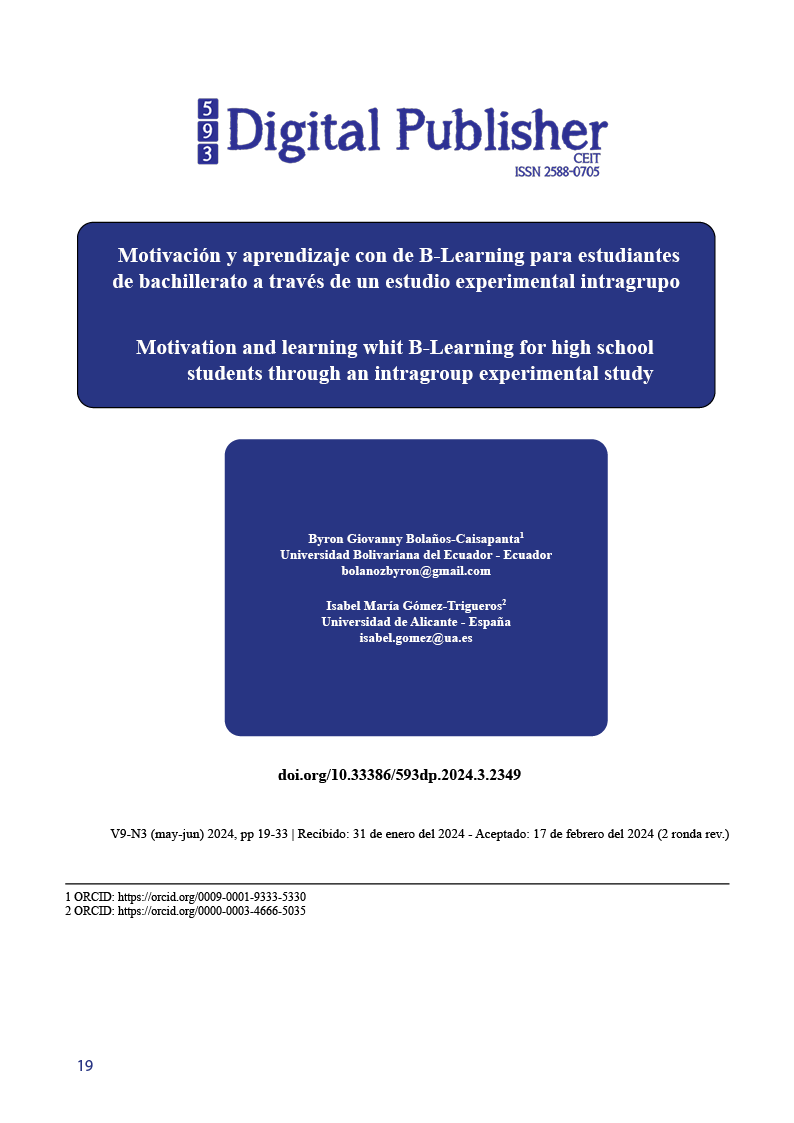Motivación y aprendizaje a través de B-Learning para estudiantes de bachillerato a través de un estudio experimental intragrupo
Contenido principal del artículo
Resumen
El presente trabajo analiza el uso de una plataforma virtual de aprendizaje dentro del proceso de enseñanza-aprendizaje como apoyo a la presencialidad para comprobar la mejora del rendimiento académico en los estudiantes de Secundaria. A través de una metodología descriptiva-participativa, cuantitativa con dos cuestionarios mixtos (pre y post) validados como instrumentos de la investigación, se llevó a cabo una evaluación diagnóstica en una muestra de 60 estudiantes en la asignatura de Biología de tercer curso de Bachillerato. Para ello se distribuyó el cuestionario previo a la intervención educativa con B-Learning; posteriormente, se creó un aula virtual dentro de la plataforma de Google Classroom, con los materiales disciplinares y con tareas interactivas para que los estudiantes participantes trabajaran dichos contenidos. Finalmente, se volvió a distribuir el cuestionario (post) para conocer la percepción del recurso B-Learning tras la intervención. Los resultados arrojan datos positivos sobre este tipo de recursos y plataformas en combinación con la enseñanza presencial. Además, se confirma el valor motivador de B-Learning y de las aulas virtuales para la enseñanza y el aprendizaje de contenidos concretos y su capacidad para el desarrollo de las competencias digitales de la ciudadanía del siglo XXI.
Descargas
Detalles del artículo

Esta obra está bajo una licencia internacional Creative Commons Atribución-NoComercial-CompartirIgual 4.0.
1. Derechos de autor
Las obras que se publican en 593 Digital Publisher CEIT están sujetas a los siguientes términos:
1.1. 593 Digital Publisher CEIT, conserva los derechos patrimoniales (copyright) de las obras publicadas, favorece y permite la reutilización de las mismas bajo la licencia Licencia Creative Commons 4.0 de Reconocimiento-NoComercial-CompartirIgual 4.0, por lo cual se pueden copiar, usar, difundir, transmitir y exponer públicamente, siempre que:
1.1.a. Se cite la autoría y fuente original de su publicación (revista, editorial, URL).
1.1.b. No se usen para fines comerciales u onerosos.
1.1.c. Se mencione la existencia y especificaciones de esta licencia de uso.
Citas
Aguilar, V. J. A., & Santana, M. Y. J. (2021). La metodología b-learning y el uso de los recursos didacticos virtuales para el proceso de enseñanza. Tesis Universidad Técnica de Machala Retrieved from http://repositorio.utmachala.edu.ec/bitstream/48000/18193/1/Trabajo_Titulacion_48.pdf
Al-Awlaqi, M. A., Barahma, M. M., Basrda, T. S. A., & AL-Tahitah, A. (2022). The effect of B-learning adoption on the evolution of self-regulation skills: a longitudinal study on a group of private universities’ freshman students. In International Conference on Information Systems and Intelligent Applications (pp. 279-290). Springer International Publishing.
Al-Tahitah, A.N., Al-Sharafi, M.A., & Abdulrab, M. (2021). How COVID-19 pandemic is accelerating the transformation of higher education institutes: a health belief model view. In: Arpaci I, Al-Emran M, Al-Sharafi MA, Marques G (eds) Emerging technologies during the era of COVID-19 pandemic. Studies in systems, decision and control (pp. 333-347). Springer, Cham. https://doi.org/10.1007/978-3-030-67716-9_21
Arias, O. M. (2010). Ambientes virtuales de aprendizaje b-learning y su incidencia en la motivación y estrategias de aprendizaje en Estudiantes de secundaria. Tecné, Episteme y Didaxis: TED, 27, 148-149.
Ariza, C. R. & Pons, B. L. (2021). Medios y redes sociales en la enseñanza-aprendizaje del inglés: valoraciones de estudiantes universitarios. REXE. Revista de Estudios y Experiencias en Educación, 20(43), 129-148. https://dx.doi.org/10.21703/rexe.20212043ariza7
Basogain, X., Angel, M., Carlos, J., & Javier, M. (2018). Computers in human behavior computational thinking in pre-university blended learning classrooms. Computational Thinking in Pre-University Blended Learning Classrooms, 80, 412-419. https://doi.org/10.1016/j.chb.2017.04.058
Bordoloi, R., Das, P., & Das, K. (2021). Perception towards online/blended learning at the time of Covid-19 pandemic: academic analytics in the Indian context. Asian Association of Open Universities Journal, 16(1), 41-60. https://doi.org/10.1108/AAOUJ-09-2020-0079
Da Silva, K. K. A., & Behar, P. A. (2017). Digital competence model of distance learning students. En International Association for Development of the Information Society (IADIS), International Conference on Cognition and Exploratory Learning in Digital Age (pp. 109-116), Algarve, Portugal, 18-20 de octubre. Retrieved from https://eric.ed.gov/?id=ED579459
Fearon C., Starr S., & McLaughlin H. (2011). Value of blended learning in university and the workplace: some experiences of university students. Industrial and Commercial Training 43(7), 446-450. https://doi.org/10.1108/00197851111171872
Fernandes, J., Costa, R., & Peres, P. (2016). Putting Order into Our Universe: The Concept of Blended Learning—A Methodology within the Concept-based Terminology Framework. Education Sciences, 6(2), 15. https://doi.org/10.3390/educsci6020015
García-González, L. A., & Solano-Suarez, A. (2020). Enseñanza de la Matemática mediada por la tecnología. EduSol, 20(70), 84-99. Retrieved from http://scielo.sld.cu/scielo.php?script=sci_arttext&pid=S1729-80912020000100084&lng=es&tlng=en
Autores (2023)
Ibáñez, F. (2020). Educación en línea, Virtual, a Distancia y Remota de Emergencia, ¿cuáles son sus características y diferencias? Instituto para el Futuro de la Educación. Tecnológico de Monterrey. Retrieved from https://observatorio.tec.mx/edu-news/diferencias-educacion-online-virtual-a-distancia-remota/
Järvelä, S., Malmberg, J., & Koivuniemi, M. (2016). Recognizing socially shared regulation by using the temporal sequences of online chat and logs in CSCL. Learning and Instruction, 42, 1-11. https://doi.org/10.1016/j.learninstruc.2015.10.006
Le, H. T. T., Nguyen, N. L. T., Nguyen, T. T., Nguyen, N. T., & Nguyen, H. T. T. (2022). Application of blended learning in teaching and learning at high schools in Vietnam. In Educational Innovation in Vietnam (pp. 206-222). Routledge.
Lohse, H., Kunina, O., & Kunter, M. (2013). The role of educational psychology in teacher education: expert opinions on what teachers should know about learning, development, and assessment. European Journal of Psychology of Education, 28(4), 1543-1565. Retrieved from https://www.jstor.org/stable/23580923
Mingorance, Á. C., Granda, J., Rojas, G., & Alemany, I. (2019). Flipped Classroom to Improve University Student Centered Learning and Academic Performance. Social Sciences, 8(11), 315. https://doi.org/10.3390/socsci8110315
Monguet, J., Fábregas, J., Delgado, D., Grimón, F., & Herrera, M. (2006). Efecto del blendend learning sobre el rendimiento y la motivación de los estudiantes. Interciencia, 31(3), 190-196.
Molina-Garzón, N. C., & Palma-Villavicencio, M. M. (2022). Metodologías activas en entornos virtuales: Propuesta didáctica para el desarrollo de competencias contables. Episteme Koinonia,5(1), 950-978. https://doi.org/10.35381/e.k.v5i1.2142
Orozco, C., Labrador, M., & Palencia, A. (2002). Metodología. Manual teórico práctico de metodología para tesistas, asesores, tutores y jurados de trabajos de investigación y ascenso. Ofimax de Venezuela.
Owen, H., & Dunham, N. (2015). Reflections on the Use of Iterative, Agile and Collaborative Approaches for Blended Flipped Learning Development. Education Sciences, 5(2), 85-103. https://doi.org/doi:10.3390/educsci5020085
Raykov, T., & Marcoulides, G. (2017). Evaluation of True Criterion Validity for Unidimensional Multicomponent Measuring Instruments in Longitudinal Studies. Structural Equation Modeling: A Multidisciplinary Journal, 24, 599-608. Retrieved from https://tinyurl.com/ysc25yc5
Ruiz, C. (2011). Tendencias actuales en el uso del B-Learning: Un análisis en el contexto del tercer congreso virtual Iberoamericano sobre la calidad en educación a distancia (EduQ@2010). Investigación y Postgrado, 26(1), 9-30. Retrieved from http://ve.scielo.org/scielo.php?script=sci_arttext&pid=S1316-00872011000100002&lng=es&tlng=es.
Sáiz, M. C., Marticorena, R., García, C. I., & Díez-Pastor, J. F. (2017). How do B-learning and learning patterns influence learning outcomes? Frontiers in Psychology, 8, 745. https://doi.org/10.3389/fpsyg.2017.00745
Salinas, I. J., de Benito C., B., Pérez, G. A. & Gisbert, C. M. (2018). Aprendizaje mixto, más allá de la clase presencial. Revista Iberoamericana de educación a distancia, 21(1),195-213. https://doi.org/http://dx.doi.org/10.5944/ried.21.1.18859
Strang, K. D. (2017). Beyond engagement analytics: which online mixed-data factors predict student learning outcomes? Education and Information Technologies, 22, 917-937. https://doi.org/10.1007/s10639-016-9464-2
Tomalá, M. A., Gallo, G. G., Mosquera, J. L., & Chancusig, J. C. (2020). Las plataformas virtuales para fomentar aprendizaje colaborativo en los estudiantes del bachillerato. Recimundo, 4(4), 199-212. Retrieved from https://recimundo.com/index.php/es/article/view/899/1622
Tunmibi, S., Aregbesola, A., Adejobi, P., & Ibrahim, O. (2015). Impact of E-Learning and Digitalization in Primary and Secondary Schools. Journal of education and practice, 6(17), 53-58. https://eric.ed.gov/?id=EJ1079751
Valverde-Berrococo, J., & Balladares B., J. (2017). Enfoque sociológico del uso del b-Learning en la educación digital del docente universitario. Sophia, 23, 123-140. https://doi.org/10.17163/soph.n23.2017.04
Wang, Y., Han, X., & Yang, J. (2015). Revisiting the blended learning literature: Using a complex adaptive systems framework. Educational Technology & Society, 18(2), 380-393. http://www.jstor.org/stable/jeductechsoci.18.2.380
Xinogalo, S. (2015). Object-oriented design and programming: an investigation of novices' conceptions on objects and classes. ACM Transactions on Computing Education, 15(3), 1-21. https://doi.org/10.1145/2700519
Yousef J.H., Alhourani M.I., & Al-Srehan H.S. (2022). Blended learning: the amount of requisite professional competencies in faculty members of Al Ain University from viewpoint of students. Journal of Applied Research in Higher Education, 14(4), 1433-1448. https://doi.org/10.1108/JARHE-06-2021-0206



